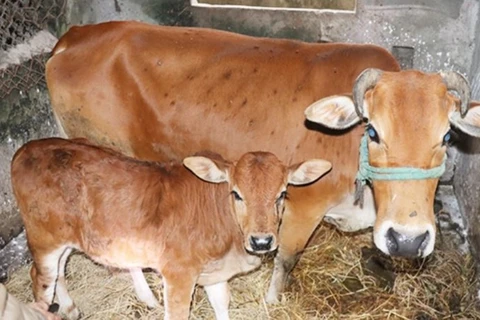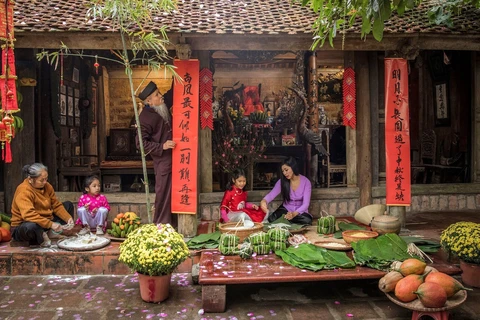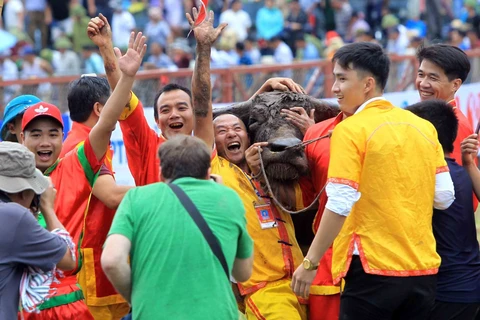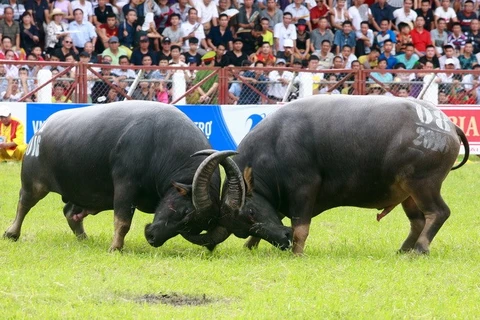Hanoi (VNA) – The Buffalo Fighting Festival is a famous traditional event that closely attaches with the name of Do Son in the northern port city of Hai Phong. It is a traditional cultural, religious or artistic activity that reflects the material and spiritual life of a community in the past.
The festival is organised annually on the ninth day of the eighth lunar month. It has become an occasion for locals and visitors to gather and enjoy the fights as a betting game.
The festival is not only associated with Water Goddess worshiping and sacrificing customs but expresses bravery, chivalry, and the risk-taking spirit of local people.
It derives from the belief of Do Son residents that the local guardian gods like buffalo fighting and hence the practice ensures safe travel, abundant crops as well as prosperity and happiness. The festival has been held in the region since the 18th century.
Like other festivals in Vietnam, the Buffalo Fighting Festival consists of two parts - spiritual rites and entertainment activities. Since the first day of the eighth Lunar month, at the communal houses of all villages in Do Son district, the elders carry out a sacrificial ceremony towards Diem Tuoc God with participation of all of the villages. The buffaloes are brought in especially for the occasion.
After that, there is a ceremony worshipping the Water Goddess, in which the holy water is changed each year and given to each village to worship in their own village hall. Also, owners lead their fighters towards village halls to carry out the Tutelary God Worshipping rite. After this sacred ceremony, each fighting buffalo is officially called “Sir Buffalo”, representing local spiritual life, hopes, and beliefs.
Before the fight, dozens of men and women dance with flags, beat drums and cheer. The buffaloes are then led to the ring and proceed to fight in pairs.
They use their strength to butt each other and lock horns to the resounding cheers of local residents and tourists. The winning buffalo meets its fate in ceremony, a sacrifice to please and worship the Water Goddess.
The fighting buffaloes must meet a wide range of aesthetic requirements. They must be at least four or five years old, have a wide chest, bow-shaped horns, toned thighs, and a long tail.
According to experts, what makes the Do Son Buffalo Fighting Festival special is a testament to the unique combination of many local communities.
The Do Son Buffalo Fighting Festival was recognised as one of the 15 official national festivals in 2000 and a national intangible cultural heritage in 2012.
This year, after two years of cancelation due to impacts of COVID-19, the festival will take place at Do Son district’s stadium in Hai Phong northern port city from August 27 to September 5, offering prizes totalling 130 million VND (5,470 USD).
As the stadium has a capacity of only 20,000 seats, a large-sized screen will be set up outside the venue to serve spectators.
Pham Hoang Tuan, Vice Chairman of the People’s Committee of Do Son district, head of the festival’s organing board, said the festival this year has many new features from an enhanced security protection to a variety of new public relations events and improved communications work.
He said the festival includes two parts – spiritual rites and festivities - with the first part comprising activities such as incense offering and flag raising ceremonies, and procession, among the events included in the festival.
Sixteen buffaloes will take part in the competition.
To ensure the festival’s safety, the organising committee will erect and reinforce the yard with three layers of fences, and arrange emergency exits for buffaloes and staff serving the competition.
A range of activities will be organised within the framework of the event, including a Bolero music night live show on September 2 evening and an electronic dance music (EDM) festival on September 3. The street music programme and Vietnamese village fair will be held on the occasion.
Tuan added that efforts will also be made to avoid the commercialisation of the festival, thus maintaining its traditional value./.
























